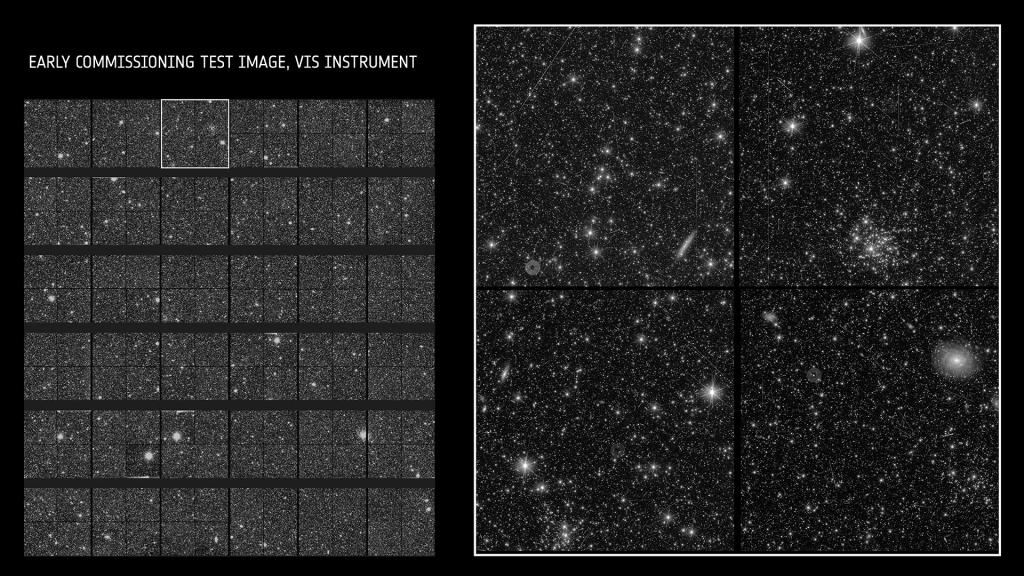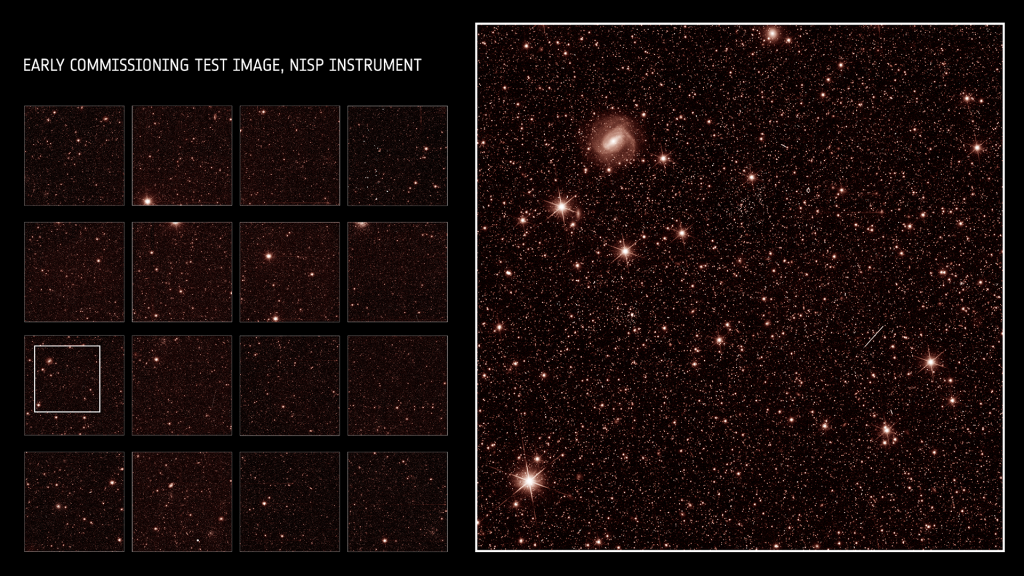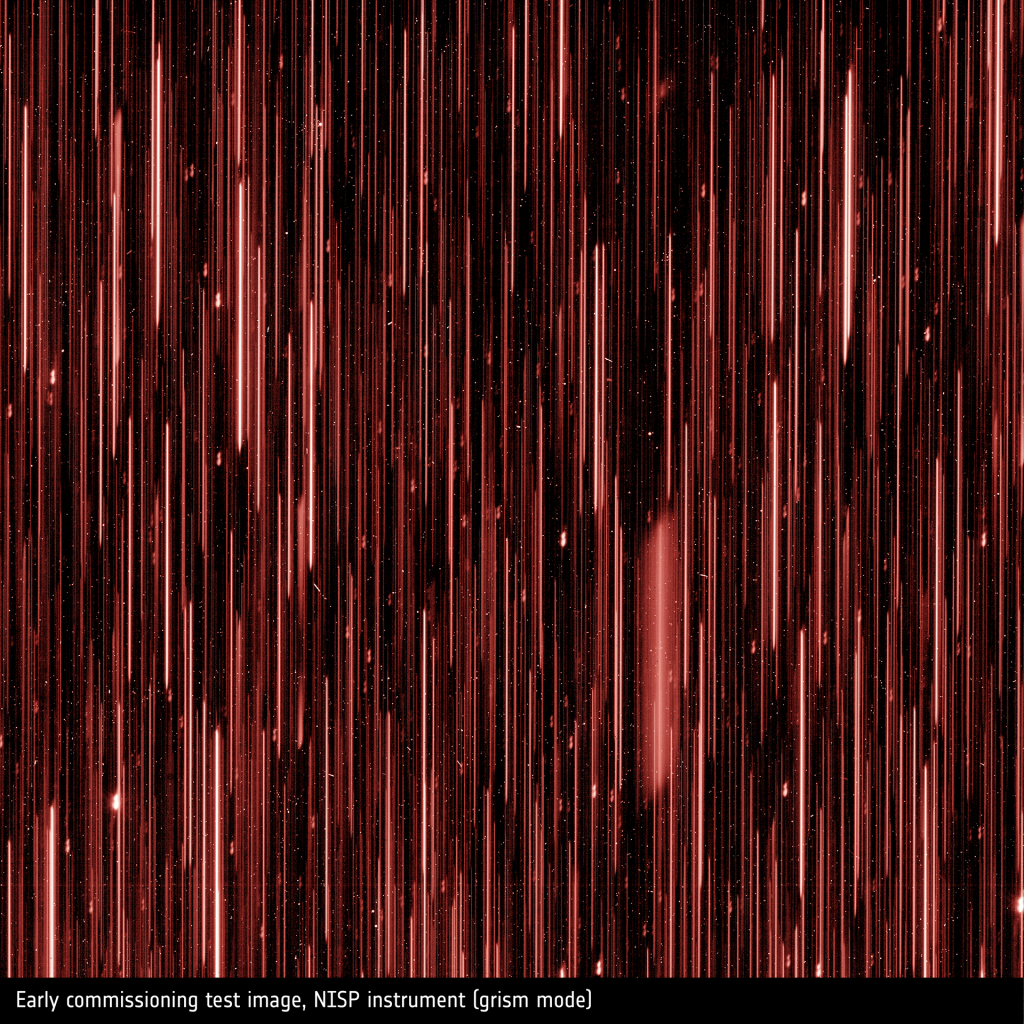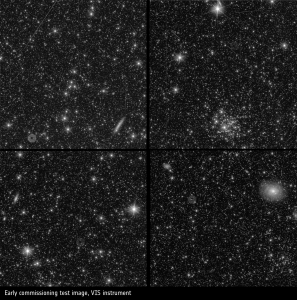Euclid’s two instruments have captured their first test images. These fascinating results indicate that the space telescope will achieve the scientific objectives for which it was designed, and perhaps even more.
The Euclid satellite, launched from Cape Canaveral on July 1st, is traveling to reach its orbit at the second Lagrange point, which it should reach in early August. This transit time has been used to commission Euclid, checking the satellite’s services such as communications, power, and pointing, and then the two instruments, VIS and NISP, as well as fine-tuning the telescope’s focus. The instrument teams have just released the first “raw” images (untreated) to mark the success of instrument commissioning.
Marc Sauvage (astrophysicist at DAp/Irfu and one of the two French representatives on the Euclid consortium council): “These images perfectly match what we had simulated, but in a simulation, we know that everything we see was deliberately placed there, so in a way, it’s not surprising. Here, everything we see is real, and nothing we see was known at this level of detail; it makes us want to look into every corner, to enlarge everything to see as much detail as possible. And since there is a tremendous amount of detail in just these two images, it becomes dizzying!“
Michel Berthé (Euclid project leader at DAp/Irfu): “I am truly amazed by the beauty of these images and the amount of information that can be found in them. We are only at the very beginning of the analysis of these initial results, but they are already very promising.
All the teams at CEA who have worked for more than 10 years on the design, production, and testing of the elements we have provided for the VIS and NISP instruments are particularly proud of these initial results, which demonstrate the nominal operation of our supplies as well as the entire satellite.“

The First Images from the VIS Instrument
Figure 1 (a single detector) shows stars, star clusters, and galaxies. All stars exhibit six peaks due to diffraction effects in the telescope. The image contains several large galaxies, at the bottom right, but also other galaxies at the edges of the image in the other quarters of the detector. Among the myriad fainter objects, many, if not most, are faint distant galaxies that are small enough to resemble stars. These galaxies, with their shapes measured, will provide a significant amount of information about dark matter and dark energy.

Traces of particles (primarily protons) traveling through space and striking the detectors are also observed, along with three donut-shaped ghosts caused by reflections in Euclid’s optical system. The image is presented in its raw state, without any processing. The exposure duration is 566 seconds, just under 10 minutes, and the considerable number of tiny stars and galaxies indicates that the VIS has reached the required high sensitivity level.
Figure 2 shows the complete mosaic of the 36 detectors. Since all detectors are exposed simultaneously, each VIS image weighs 1.2 gigabytes.
The First Images from the NISP Instrument
For the infrared instrument, the NISP spectro-imager, Irfu provided cryomotors for mechanisms operating at very low temperatures with high precision, allowing the rotation of wheels to switch between photometric and spectroscopic modes.
Jean-Christophe Barrière (instrumentation engineer at DIS/Irfu): “After the excitement of the Falcon 9 rocket launch, we were very eager to see the first images. The three intensive weeks of testing since early July show that Euclid is performing very well, and our mechanisms are working perfectly. We can be proud of what has been achieved and hand over to scientists to exploit the instrument’s data.”
NISP, designed to make distance measurements to reconstruct a 3D map of the universe, can produce images in both photometry and spectroscopy. Figure 3 is an image of the 16 detectors making up the focal plane of the instrument, produced in a single 100s exposure. The images arrive in black and white, but for visualization purposes, they have been colorized in red here. The photometric image is similar to that of VIS but taken through one of the three light filters in NISP (here between 950 nm and 1192 nm). It is not the same region of the sky as VIS, but it contains certain types of astronomical objects such as stars and galaxies, including a prominent spiral galaxy in the upper left.

Figure 4 is an image from NISP in spectroscopy, taken through a dispersive object, a grism, here a red grism covering roughly the same wavelength range as the filter. All the objects seen in image 2 in photometry are dispersed into a spectrum of light. Thus, each vertical line in image 4 corresponds to an object from image 3.
Like the VIS images, the NISP images have undergone no processing and contain effects that will need to be cleaned up in the processing chain developed by the ground segment.

Over the next few months, the period of necessary tests and verifications continues. At the end of this commissioning and performance verification phase, ESA will release a new series of images to showcase what the mission is capable of, and Euclid’s scientific survey will begin.”
Contacts DAp/Irfu: Marc Sauvage, Michel Berthé
More information:
- ESA press release: Euclid test images tease of riches to come
- Euclid’s blog ESA – Follow Euclid’s first months in spac
Brief explainer on what kind of artefacts are commonly visible in the First Light By Knud Jahnke / 2023-08-01 What’s in Euclid’s First Light images? – Euclid Consortium (euclid-ec.org)
- Webb and Gaia welcome Euclid to L2 : vidéo ESA


